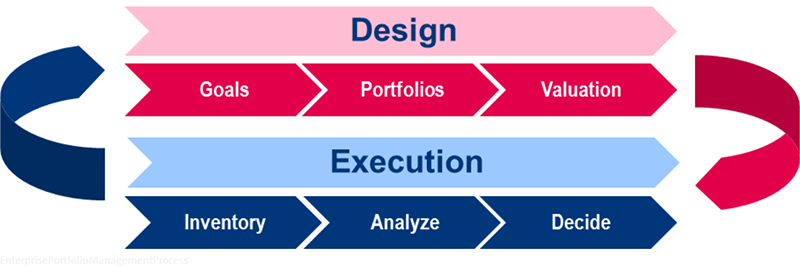Enterprise Portfolio Management (EPM) is the discipline that supports this allocation of investments to various asset categories of the organization, such as capabilities, applications, or infrastructure. EPM helps to create a healthy set of projects and programs that realize strategic goals.
The enterprise portfolio management process consists of two main phases. First, there is a design phase in which the process is tuned to the specific requirements of the organization. The organization’s goals and stakeholders are investigated, suitable portfolios are defined and valuation criteria are chosen. This phase is repeated regularly so that the EPM process is up to date with the business strategy, addresses actual concerns of the stakeholders and reflects lessons learned.
The execution phase is a continuous process in which first the assets or change initiatives are inventoried, then the portfolios are analyzed, decisions are based on this analysis, and these are input to the realization. This is repeated regularly, with a rhythm that depends on the portfolios’ characteristics.
These two phases are aligned with the Portfolio Definition and Portfolio Delivery cycles of the Management of Portfolios (MoP®) standard, making it easy to use our approach in an MoP context.

An organization needs a pragmatic way to get started with EPM, i.e., a crawl, walk, run approach. This should gradually extend the portfolio management process to the maturity level that is suitable for your organization.
In the first step of the design phase, you need to agree on the scope of the approach. For example, it is important to decide which part of the enterprise, application landscape or project portfolio is considered first and what the focus of the analysis will be. This discussion on scope needs to be conducted with all disciplines involved, like enterprise architects and project portfolio managers.
An easy start means that the metrics used to analyze the portfolios should be generic and easy to agree on by the stakeholders involved. It also means that the data should be readily available in the organization. It is important to be realistic on what can be accomplished in the first months. This depends on the state of the architecture on which the portfolios are built, on the availability of data and the culture within an organization.
After a successful start, it is important structurally to embed the portfolio management processes in the organization. The small and simple valuation models used for the initial quick start can now be extended gradually.
After your first experiences with portfolio management, you can extend its scope and use it for more strategic purposes. For assets, you might continue by cleaning up the current landscape by rationalizing your asset portfolios within a manageable part of the enterprise, and gradually growing them from there. Gather data on the life cycle of these assets (such as applications), in relation to the business capabilities or initiatives they support, e.g. via business value / technical value analysis. Do a more detailed analysis of the 20% most important (e.g. critical, expensive, risky) assets, and a quick scan of the remaining 80%. Use this to decide on investment priorities for your asset categories.
For projects and other change initiatives, you could define some project portfolios that support this clean-up/life cycle management process. Start with simple, qualitative scoring criteria (cost, benefit, risk, strategic importance at a scale of high, medium, low). If available, use your enterprise architecture to help decide on the order of changes. Add some portfolios to support specific business themes, e.g. based on capabilities.
As your portfolios grow, their dependencies become more important. Link portfolios of projects and other change initiatives to the portfolios of assets to which they contribute, and eventually to the business capabilities and goals they support, using EA as a mediator/knowledge hub.
Hope you have found this blog useful, and stay tuned for more blogs on EPM!